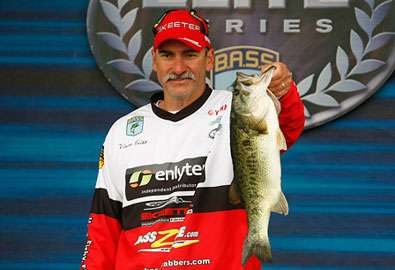
Some things never go out of style. Old-time topwater baits are one of them. No matter how much engineering, new materials or cutting edge know-how go into modern topwater baits, they'll never outperform the old standbys. It just won't happen. The vintage baits have a unique quality that can't be duplicated.
My favorite is the old Heddon Tiny Torpedo. I still relive, from time to time, how I won my first bass tournament throwing one with my cousin. That day and that lure will remain in my memory forever.
This short, fat chunk of wood with a single prop on the back will catch bass with a slow stop-and-go style of retrieve. Let it sit until the rings are three feet from it before you move it again. Or you can retrieve it steadily, like a buzzbait. You can throw it into calm water or when there's a little ripple on top from a spring breeze.
Another good one is the old Heddon Lucky 13. It's a lot bigger, doesn't have a prop, has a deep concave mouth and comes equipped with three big treble hooks. Pop it along slow and easy on a calm day or retrieve it a little faster and make a ruckus if there's a chop on the water. Either way it'll load the boat for you.
The long, slender double-propped Smithwick Devils Horse is another old-timer that deserves special recognition. There's not a better topwater lure on the planet. I have four of the originals and guard them with my life. I never fish with them unless there's money on the line.
Now, if you're thinking I forgot the Fred Arbogast Jitterbug or the Heddon Zara Spook, fret not. I haven't. They've been around forever and the old ones still catch fish like they did the day they were first put on the market.
Why these lures still catch fish is a fair question. The answer is simple (at least so far as we know the answer). Bass don't remember very long. And even if they do, they don't pass their knowledge from one generation to another. So a bait that hasn't been thrown for years is a new one to the bass, regardless of how long it's been buried in your tackle box.
Don't kid yourself. These lures are well-designed. They do exactly what they need to do to evoke bone jarring strikes from big bass. Just because computers and professional bass fishing didn't exist when these baits were first introduced doesn't mean the men who made them didn't know what they were doing. They did.
Another thing I love about these baits — a theory of mine, really — is that the old wood doesn't roll like plastic during the retrieve. Therefore, the bass don't see the color change from the mostly white bellies to the more colorful back designs.
I think the bass know the roll on a lot of the modern baits is unnatural, that it isn't right. We all know that when bass sense something isn't right — even though they might not know what it is that's not right — they shy away from it.
Wood floats differently, too. Again, I don't know if it floats higher, has a better bounce, rides the water better or what. It's just different, and that difference is attractive to bass. I've thrown the old stuff alongside the new and, frankly, I can't tell the difference. But, throw both those baits on a day when the topwater bite's hot and the bass will show you the difference.
Now, to make these baits work properly you'll need the right tackle. Choose a long rod — around 7 feet is about right — with a medium-heavy action. My preference is for a custom-made stick by Buti Rods in Roff, Okla.
I like a high-speed Shimano reel for my topwater baits. It lets me fish them slow or fast, as necessary. And when I want to bring my bait in quickly for another cast, I can do so effortlessly.
Line is the most important piece of equipment when it comes to fishing topwater lures made from wood. Always use copolymer or monofilament. It floats. Never use fluorocarbon line. It's heavy, and it sinks. That'll pull the nose of your lure down, ruin the bait's natural action and make long pauses impossible. Silver Thread Excalibur works the best for me.
Finally, it's time to discuss bait modification. I do not — for any reason — modify my old topwater baits. By definition they're unique in appearance and action. There's no need to mess with them.
I do, however, swap the hooks. (Some of the old hooks are really bad.) But my replacement hooks are always the same size and weight as the originals. I don't do anything that'll affect the action of my lure.
There you have it, a brief look at the topwater baits of old. Give one of them a second chance this spring. You'll be surprised at the results.





